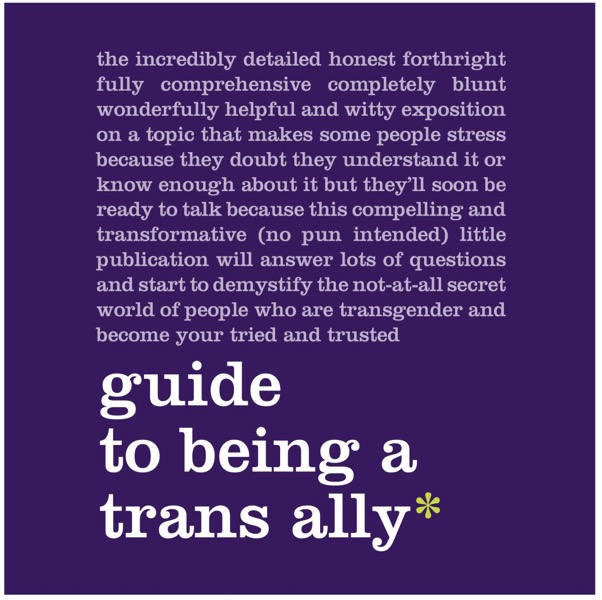Continuing my learning journey as part of #KPLantern (see: #KPLantern is beginning – Human Centered Insights into Transgender Person Health, to make it better | Ted Eytan, MD), this is a handy guide. Read it.
It’s produced by Straight for Equality (@S4Equality) which is:
….a national outreach and education project created in 2007 by PFLAG (@PFLAG) National to empower new straight allies who, unlike a more traditional PFLAG member, don’t necessarily have a family connection to the gay community.
In the era of transgender person equality, the label “straight allies” doesn’t exactly fit, and this is explained in the document, which should be read if you are planning to be there for LGBTQI people and not just a few of the letters – and why shouldn’t you be, it’s only fair.
Being an ally is something new to me, because previously the first three letters of “LGB” were the ones that needed allies. Now those people are becoming allies for the other 3 letters (Trasngender, Queer, Intersex), which is a new experience for us.
To prepare you, the guide gives a pretty thorough explanation of the difference between sexual orientation and gender identity. Again, being an ally means being informed, and it’s really up to the ally to get informed and drive their own learning.
What’s an Ally and the Equality Ally Spectrum
There’s a patent symbol next to a diagram describing the spectrum of alies so I won’t reproduce it here (see page 23).
I guess I am on the far right as the Super Ally, for reasons which I have revealed here and on the TEDx stage. I didn’t go into health care to support discrimination, and fortunately I don’t have to, which is why my generation of physicians is changing everything.
Reflections based on my ally journey
There are five key barriers listed to being an ally and five positive ways to be a trans ally, which are well described and useful:
I’m comfortable discovering things on my own and not seeking too much information from the people I’m supporting. This is very good advice, oft repeated to me. I am from a group that has allies and we know what that’s like, the inappropriate question asking.
Under “conflict aversion” I sense an excessive need to protect those who really want to learn, for their health and ours. We need to get beyond a place where people aren’t allowed to be made aware of unfair practices in employment, health care, living their lives. I like this guidance, from another source, better:
- “discrimination,” “homophobia,” “transphobia,” “bias”
- if this language makes you feel defensive, notice it and accept the discomfort of unlearning and relearning
- eliminating bias requires a desire to know, motivation to become informed, willingness to correct mistakes
- (adapted from http://www.cookross.com/docs/UnconsciousBias.pdf)
I’m less worried about people shutting down and more concerned about how much adaptation the ally (or the vulnerable population) should be responsible for in the learning process.
I have seen enough people not be served by a system that believed it was objective and compassionate, where no one dared say the words above. What you permit, you promote, and what’s health care here for.
A few additional tips from me (because it’s my RSS feed):
- Receiving anger is a sacred task – Ronald Heifetz: It will happen to you as an ally, and it’s impressive, including from fully trained physicians. Fortunately, being an ally means you know your position, and as Hillary Clinton told us in 2012:
#HillaryLunch12 @npwf “a lot of the loudest voices are last gasps” #lovewins #LBGT
— Ted Eytan, MD (@tedeytan) June 21, 2012
- Allies need allies. Get a mentor, or a group of them, speak to them regularly. I have had a few official ones and countless other informal ones, including Dana Beyer, MD (@danabeyermd) who so graciously agreed to chat with me once a month, and a new one to me, Garrett G, who can help me evaluate my ally activity and help me set the right goals. Give them credit on the journey and promote their leadership because they are the leaders.
- Speaking of the right goals, create and focus on them. There can be a temptation to have the goal be “create more allies,” which is just a means to an end.
The landmark Marmot Review of Health Inequalities (see: Now Reading: Why a focus on lifestyle behavior change may not improve health: The Marmot Review | Ted Eytan, MD) opens with this revolutionary quote:
Rise up with me against the organisation of misery – Pablo Neruda
I became an ally (and described that moment here) when I saw trans people start to take control over their own destiny. That’s when health happens, in partnership “with” rather than in partnership “for.”
As I say in the medical world, the physician’s role is to (a) bring the patient story into every conversation, then (b) create an environment where the patient can be in the conversation, finally (c) get out of the way so the patient can lead the conversation. It’s their health.
Are you having ally experiences in support of people who are trans that you’d like to share or thoughts on the above? Let me know in the comments or via twitter (@tedeytan). Thanks @PFLAG and @S4Equality for creating a ready reference for us. If you don’t know where to start, start here.
My wish is that one day people like my twin receive only gratitude, not pain and discrimination, in exchange for their courage.” —Katherine


1 Comment
[…] Just Read: Guide to being a trans ally – Straight for Equality – PFLAG National […]